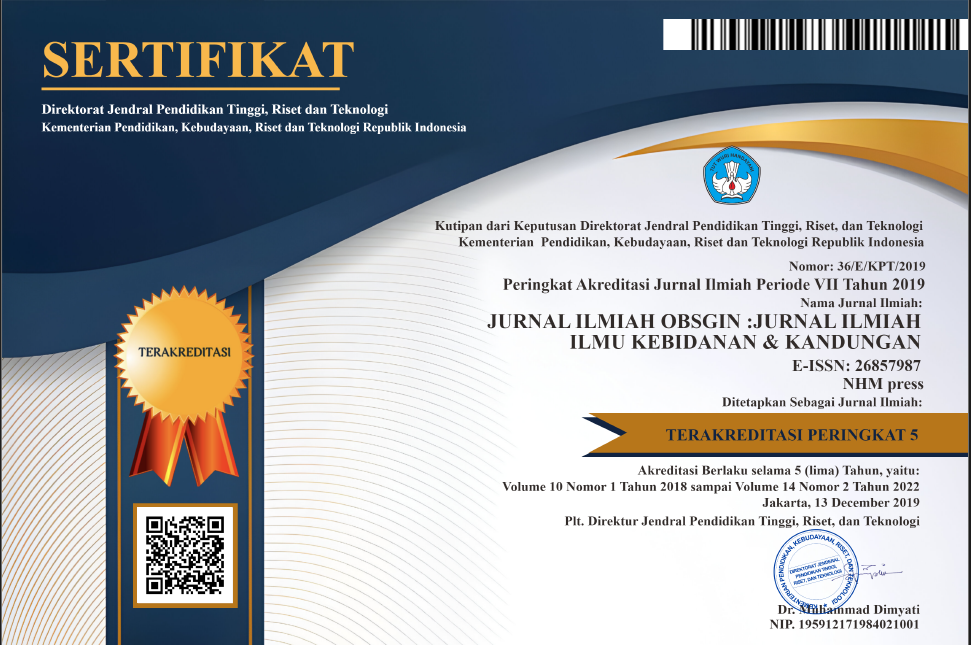The Effect of Hypnobreastfeeding Techniques on the Process of Breast Milk Expulsion in Postpartum Mothers
Abstract
Background: Exclusive breastfeeding for infants is important for their growth and development. Maternal and psychological factors in breastfeeding greatly influence the breastfeeding process and milk production. Feelings of stress, anxiety and pressure experienced by a mother can inhibit milk production. Several methods have been developed including the Hypnobreastfeeding technique. Hypnobreastfeeding helps mothers to ensure that they can continue to provide breast milk to the baby.Research Objective: To determine the effect of Hypnobreastfeeding technique on the process of breast milk production in postpartum women.Research Methods: Pre-experimental type of experimental analytics with a pretest- posttest one group design approach, namely in this paradigm there is a pretest before being given treatment so that the treatment results can be known more accurately.Research Results: Before being given the Hypnobreastfeeding Technique, the average breast milk volume was 60.50 ml and after being given the Hypnobreastfeeding Technique, the average breast milk volume was 98.40 ml.Conclusion: The results of the paired t-test conducted on the treatment group showed that the p value was 0.0001 (p<a), so there was a significant difference between the volume of breast milk before and after the Hypnobreastfeeding Technique treatment.Suggestion: It is hoped that it can make the latest innovation program about the world of Hypnosis not only Hypnobreastfeeding, it can also be used during the process of hecting anesthesia, infusion installation, and others.
References
Handayani, N., Rahayu, P., & Hasina, S. N. (2021). Hypnobreastfeeding sebagai Upaya Meningkatkan Motivasi Ibu dalam Memberikan ASI Eksklusif pada Masa Pandemi Covid 19. Jurnal Keperawatan Jiwa, 9(4), 809–816. Retrieved from https://jurnal.unimus.ac.id/index.php/JKJ/article/view/8501
Harahap, D. A. (2021). Skripsi Delima Afriani Harahap (2).
Kementerian Kesehatan RI. (2019). PROFIL KESEHATAN INDONESIA TAHUN 2019. Short Textbook of Preventive and Social Medicine. https://doi.org/10.5005/jp/books/11257_5
Komariah, N., Vasra, E., & Virgian, K. (2022). PENERAPAN HYPNOBREASTFEEDING PADA IBU MENYUSUI DI POSYANDU ANYELIR WILAYAH KERJA PUSKESMAS DEMPO PALEMBANG, 6(July), 1–23.
Muslimah, A., Laili, F., & Saidah, H. (2020). Pengaruh Pemberian Kombinasi Perawatan Payudara Dan Pijat Oksitosin Terhadap Produksi ASI Pada Ibu Post Partum. Jurnal Mahasiswa Kesehatan, 1(2), 87–94.
Novayelinda, R. (2012). Telaah literatur : Pemberian ASI dan Ibu Bekerja. Jurnal Ners Indonesia, 2(2), 177–184.
Sundari, S. W., & Imaniar, M. S. (2021). Effect of hypnobreastfeeding on the success of exclusive breastfeeding in pregnant women trimester III in Puskesmas Bungursari Tasikmalaya. JNKI (Jurnal Ners Dan Kebidanan Indonesia) (Indonesian Journal of Nursing and Midwifery), 9(2), 128. https://doi.org/10.21927/jnki.2021.9(2).128-133
WHO. (2020). No Title.











